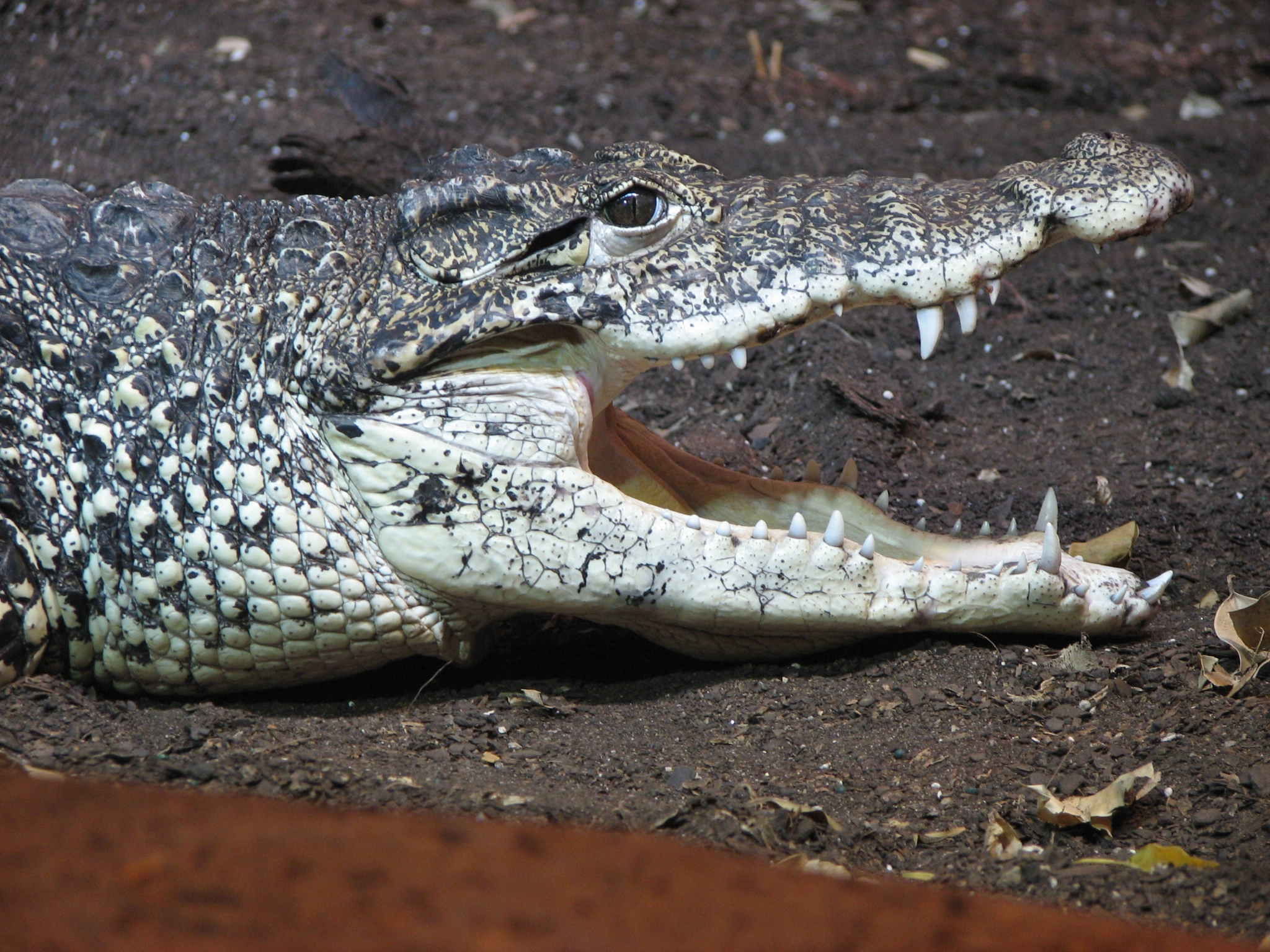- Cuban Crocodile
Taxobox
name = Cuban Crocodile
status = EN
status_system = iucn2.3

image_width = 240px
regnum =Animal ia
phylum = Chordata
classis = Sauropsida
ordo =Crocodilia
familia =Crocodylidae
genus = "Crocodylus "
species = "C. rhombifer"
binomial = "Crocodylus rhombifer"
binomial_authority = Cuvier,1807 The Cuban crocodile ("Crocodylus rhombifer") is a small species (2.4 meters average length) of
crocodile found only inCuba 'sZapata Swamp and theIsle of Youth , and highly endangered, though it formerly ranged throughout theCaribbean .This species has numerous interesting characteristics that set it apart from other crocodilians, such as its brighter adult colors, rougher, more 'pebbled' scales, and long, strong legs. This species is the most terrestrial of crocodiles, and also possibly the most intelligent. A colony of this species at
Gatorland , Florida has also exhibited what is strongly suspected to be pack-hunting behavior, which has prompted much interest in the species, usually kept singly and especially so after such reports.Habitat
The Cuban crocodile has the smallest range of any crocodile. It can be found only in Cuba in the Zapata Swamp in the northwest and in the Lanier Swamp on Isla de Juventud. The historical range also included the Cayman and Bahama islands. The Cuban Crocodile appears to favor freshwater habitat such as swamps, marshes, and rivers and rarely swims in saltwater [ [http://nationalzoo.si.edu/Animals/ReptilesAmphibians/Facts/FactSheets/Cubancrocodile.cfm National Zoo] ] .
Diet
Small fish, freshwater arthropods, and crustaceans make up the diet of young Cuban Crocodiles. Adult crocs feed upon small mammals, fish, and turtles. They have blunt rear teeth, which aids in crushing the shells of their turtle prey. Cuban Crocodiles also demonstrate the jumping feeding technique seen in other crocodilians such as the
American Alligator . By thrusting with their powerful tail, they can leap from the water and snatch small animals from overhanging branches. [ [http://www.flmnh.ufl.edu/cnhc/csp_crho.htm University of Florida] ] Fossil records suggest that they once fed on now-extinct giant ground sloths, which may have led to the evolution of their blunt rear teeth, now used for crushing turtle shells.Conservation
The Cuban Crocodile is an endangered species, listed on
CITES appendix 1. Its restricted habitat and range make it very vulnerable. The Cuban crocodile’s main threat is humans, who have hunted the crocodile extensively and have largely encroached upon their habitats. There is still much research to be done on the remaining wild populations of the Cuban Crocodile. The Cuban Crocodile is represented in captivity in the United States, where breeding projects are taking place. There have been problems in the past with hybridisation, which limits the pure gene pool of this species. [ [http://www.flmnh.ufl.edu/cnhc/csp_crho.htm University of Florida] ] Today, 3,000 to 6,000 Cuban crocodiles are estimated to live in the wild in a 186-square-mile (300 km2) section of the southwestern part of the swamp. Because much information on the ecology and natural history of the Cuban crocodile is still unknown, work needs to be done to increase and protect the remaining wild population.Description
Adult Cuban crocodiles generally do not exceed 10.5 feet (3.5 meters) in length, with males being larger than females. Fifteen-foot (5 m) individuals have been found in the past, but are rare. The Cuban crocodile has a short, broad head with a bony ridge located behind the eyes. Large osteoderms from the dorsal shield extend onto the back of the neck. Scales on the legs are larger than usual and heavily keeled on the two rear legs. Coloration is darker on the top portion of the body, consisting of a pattern of black and yellow speckles. The belly of the Cuban crocodile is pale with no distinctive markings. The tail is marked with black blotches and/or bands.
Cuban crocodiles have a total of 66 to 68 large teeth, especially adapted for crushing turtle shells. They have feet with reduced webbing that aid the Cuban crocodile on land, enabling them to move with agility and power.
Cuban crocodiles are strong swimmers and are also adept at walking and leaping. This makes them equally at home in water or on land. Temperature control is important because they cannot generate heat metabolically. They soak up heat from the sun or warm water, generally in the morning, when they are cold and groggy, or after a meal, because the heat raises their metabolisms. There is a dominance hierarchy among crocodiles based on sex, size, and temperament. This species may live for about 50 to 75 years
Reproduction
Little is known regarding the nesting behavior of the Cuban crocodile. Cuban crocodiles construct mound nests. The breeding season generally begins in May and lasts for three to four months. The number of eggs produced depends upon the size and age of the mother but 30 to 40 eggs is average. A large number of eggs are produced to compensate for the fact that a large percentage of hatchlings do not survive. This is due to a variety of factors, primarily predation on both eggs and hatchling crocodiles by various mammals, reptiles, and birds. Cannibalism of young by more mature Cuban crocodiles has also been reported. The eggs are about two to three inches (5 to 7.6 cm) in length. The eggs typically hatch 58 to 70 days after they are laid. The sex of the hatchlings is determined by the temperature of the nest.
Source of Information
All or part of this information was provided by the link to Animal Diversity Web and Museum of Zoology of the University of Michigan.It appears here with their permission. The original author of this information was Kristen Pettit.
For more information, including references, see the Animal Diversity Web account for this species, here:link to http://animaldiversity.ummz.umich.edu/site/accounts/information/Crocodylus_rhombifer.html.
References
External links
*Crocodilian Online on the Cuban Crocodile [http://www.flmnh.ufl.edu/cnhc/csp_crho.htm]
* [http://www.flmnh.ufl.edu/natsci/herpetology/act-plan/crhom.htm Cuban crocodile species account]
*Cuban Crocodile Fact Sheet [http://nationalzoo.si.edu/Animals/ReptilesAmphibians/Facts/FactSheets/Cubancrocodile.cfm]
Wikimedia Foundation. 2010.
